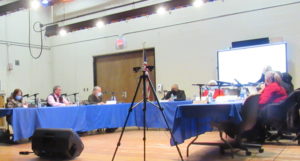By Harold C. Ford
[Editor’s note: Harold C. Ford, Education Beat writer for East Village Magazine (EVM) for nearly six years, attended two education board meetings within 24 hours. He was present at the University of Michigan (UM) Board of Regents meeting, held in Flint Oct. 20. He started to watch the You Tube recording of the Oct. 12 Flint Board of Education (FBOE) meeting Oct. 21 as he was out of the country and unable to attend the meeting in-person. He stopped watching the 5.5-hour FBOE meeting at the 3:45 mark when the Flint Board passed its first substantive motion; he went for a walk instead. He opted to write a piece that would reflect on the two meetings. Readers are invited to watch recordings of both meetings available on YouTube here for FBOE and here for UM.]
Within nine days, two education board meetings were publicly held in Flint. On Oct. 12 and Oct, 21 the governing boards of Flint Community Schools (FCS) and the University of Michigan met, respectively. While both boards share many commonalities, the differences between the two were stark. This Education Beat piece will compare and contrast the two.
COMMONALITIES
Democratically chosen: FBOE members are chosen by City of Flint voters; board terms are six years unless a vacancy is filled. UM regents are chosen by voters in the state of Michigan; board terms are eight years unless a vacancy is filled.
Board responsibilities: Both boards oversee and evaluate the performances of its chief executives, set policies and procedures, and attempt to provide for the well-being of the educational institutions they govern. FCS has one superintendent and eleven buildings. UM has a president at its Ann Arbor campus and one chancellor at each of its campuses in Dearborn and Flint.

(Graphic source: www.umflint.edu)
Public comments: Both boards allow for public comment during their meetings with a two-minute time limit for each speaker. Fifteen persons spoke at the beginning of the Oct. 12 FBOE meeting. Sixteen persons addressed the UM board near the end of its meeting on Oct 21.
Purpose: The primary responsibility of both governing boards should be to provide the best education possible for its students.
Critical issues: Both governing boards grapple with important issues that some would deem existential. The COVID-19 pandemic, declining student enrollment, and budgetary challenges have recently plagued both K-12 and higher education institutions. Enrollment at the University of Michigan-Flint (UM-F) has fallen from 8,574 students in 2014 to 5,985 in 2022. Student enrollment in Flint’s public schools has fallen from nearly 47,000 in 1971 to slightly less than 3,000 at last report by the FCS superintendent.
UM-F is now facing an uncertain Strategic Transformation plan advised by Huron Consulting Group that engineered severe austerity programs at the University of Wisconsin, the University of New Hampshire, and elsewhere. FCS faces several serious challenges: deteriorating infrastructure; staff shortages; poor standardized test scores; legal entanglements; and the looming return of indebtedness approaching $20 million.
CONTRASTS
Size: The FBOE oversees a district of about 3,000 students in eleven buildings in one city, Flint. The UM Board of Regents oversees about 59,000 students on three sprawling urban campuses in Ann Arbor, Dearborn, and Flint. With a student enrollment nearly 20 times that of FCS, one might logically conclude that the UM board would oversee a staff and budget at least 20 times that overseen by the FBOE.

FBOE meets at the Accelerated Learning Academy. (Photo by Harold Ford)
Meeting length: The October FBOE meeting ended 5.5 hours after its scheduled start, the UM meeting ended in one hour and 43 minutes.
Productivity: The FBOE passed its first substantive motion at the 3:45 mark of the Oct. 12 meeting as members voted 6-0 to approve the list of employee retirements and resignations submitted by FCS administration. Prior to that vote, the FBOE voted on two procedural motions and received a single report on the district’s hydration stations. The following business was conducted at UM’s 103-minute meeting: the regents approved the appointment of Santa Ono as UM’s new president, four committee appointments, and 273 other personnel decisions; 18 reports were made; another 11 additional reports and/or action items were accepted.
Decorum: The UM board moved expeditiously through its agenda with minimal commentary and no parliamentary snafus. The Flint board was plagued, as in past meetings, by plentiful parliamentary interjections (points of information, points of order), ongoing intra-board tensions, repetition, long orations, and multiple agenda redirects.
“Excuse me,” a frustrated audience member shouted at one point during the Oct. 12 Flint meeting. “You’ve just been repeating yourself over and over again … Could we get to some point where we advance the meeting?”
- McNeal: “Who runs behind those kids?”
- Audience members: “Parapros.”
- McNeal: “Who wraps they arm around them?”
- Audience members: “Parapros.”
- McNeal: “Who sits with them?”
- Audience members: “Parapros.”
- McNeal: “Who cleans up behind them?”
- Audience members: “Parapros.”
- McNeal: “Who sneaks out of the building and goes get them something to eat?”
- Audience members: “Parapros.”
Flint’s intra-board tensions were on full display once again as in a lengthy give-and-take between FBOE President Carol McIntosh and Trustee Laura MacIntyre about the demolition of Flint Central (starting at about the 1:02 mark of the YouTube recording). Some excerpts of that exchange:
- MacIntyre: “We, as a board, have not gotten any communications from our board president (McIntosh).”
- McIntosh: “Not true.”
- MacIntyre: “There have been no subcommittee meetings. The bylaws have not been followed.”
- McIntosh: “Point of information … This is not personal attacks.”
- MacIntyre: “Point of information. This is germane to the topic.”
- McIntosh: “No, it is not.”
- MacIntyre: “It is.”
- McIntosh: “Point of order. You are off the topic.”
- MacIntyre: As far as I’m concerned, this is an illegitimate agenda item.”
The remaining announced meetings of the Flint Board of Education in 2022 are Oct. 26 (moved from Oct 19), Nov. 9 & 16, Dec. 14 & 21. Meetings can be viewed remotely or in person. Meetings start at 6:30 and are held at the ALA building, 1602 S. Averill, Flint, MI 48503. Additional details are available at the district’s website: www.flintschools.org.
EVM Education Beat reporter Harold Ford can be reached at hcford1185@gmail.com.


You must be logged in to post a comment.